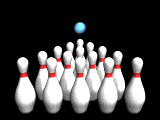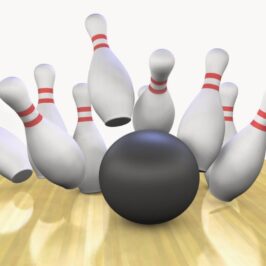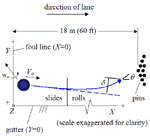Bowling is about two things – The game and Fun. When it comes to the game, it becomes arguably about who can throw the most strikes, whether in handicapped or scratch bowling. Enough strikes can nullify any handicap. And yes, spares can make or break a game, but think about it, if there had been a strike thrown, there would be no problem, no spare to throw –
It has been said that The game of bowling is played at the ankle!
To answer that one has to look at what it takes to get the ball to the lane.
There are several things that must all come together to do this.
- When I first pick up my ball, I check for oil. This tells me how the ball runs.
- Next the fingers are fitted, then the ball is set on the thumb. I tend to use very tight finger grips. This is a personal preference.
- I then take some long, deep, slow breaths and concentrate on my “mark”, the spot on the lane where I want the ball to go. It has been shown that taking 3 seconds or more seems to work better.
- The ball is dropped into motion with the arm as the arm of the pendulum, straight as possible and at the target. Momentum and rotation are decided and applied here.
The focus of one’s shot comes down to half a second of application that takes place roughly at one’s ankle. All the approach, the aim, the amount of twist, are concentrated into what happens in that period and space.
 The goal is to impart enough spin and velocity onto the ball, at the nearest “correct” angle, in order to have it travel down the lane and knock down all the pins, or strike. That entire sequence comes to its summation when the ball first contacts the lane. Where one imparts the energy and direction, is at release. From there its all Newton. We, as humans, are out of the equation except for what “body English” can be exerted.
The goal is to impart enough spin and velocity onto the ball, at the nearest “correct” angle, in order to have it travel down the lane and knock down all the pins, or strike. That entire sequence comes to its summation when the ball first contacts the lane. Where one imparts the energy and direction, is at release. From there its all Newton. We, as humans, are out of the equation except for what “body English” can be exerted.
To calculate where the ball will go from there is rocket science. Ball speed, rotation, angle of that rotation, AIM, and those all important lane conditions. This is what our brains have to figure out in short order. One is not just adjusting aim, but applying varying amounts of force toward both rotation and ball speed, after analyzing lane conditions.
Where the ball first contacts the pins in a strike shot is called the “sweet spot”. How one gets to that point takes some doing, and Yup, some if it really IS rocket science.
-
Before we go any further, I want to introduce us to a cruel concept. This is one many of us may not cater to, or be comfortable with, a game maker-breaker:
When I first started to bowl, I couldn’t help but notice that most of the better bowlers, bowled a lot. Some “lived” in the alleys. And yeah, there was that person who seemed to have the gift without practice, but – – -. Practice rules! Nuff Sed.
When you come up to bowl the first thing on one’s mind is the pins, 60 feet away, down a narrow lane. Just how narrow? Right at the limit of what the eye can see. So if you’re looking at the pins, calculating just where to have the ball hit the pins is a real challenge.
Enter lane markers. These are the arrows and dots on the lane itself. Lets take a look at them before we back up to how we get the ball to these markers.
Notice the dots and arrows on the lane above. On Brunswick lanes there are additional markers placed at the breakpoint. These are used for aiming. Due to the distance the pins are from the bowler, aiming is done with the help of these markers. They work for both straight and hook ball bowlers. Knowing how to use them to make your particular shot is very important, if not life threatening, bowling wise.
Coming out – Setting up. Our shot starts when we first come out onto the approach area. It’s here that you calculate the angles used to hit the pins where you want. One makes the decision on exactly where to stand, which mark to hit, how much forward energy, and especially, amount of rotation, to put on the ball at this point. It is here we acquire the target. This is where that great calculator of time, velocity, distance, the brain, takes over. This is where taking slow and easy breaths, clearing out the mind of distraction, becoming focused, is paramount. Some studies have shown that a minimum of about 3 seconds of concentration on the target helps increase accuracy. There is a stage of concentration where all the math and physics are loaded and the calculations are sent the background. The concern then is execution – Following through.
Aiming

 With a straight ball, the name of the game is consistency. There is one spot common to both styles that needs to be hit in order to generate strikes. This is sometimes called the “sweet spot”, between the 1 and 3 or 1 and 2 pins if you’re left handed. To hit that spot with a straight roll requires the ball pass over the same lane mark every time. This is where Consistency and Concentration rule – the challenge is to get the body and mind in sync. One has to line up the sweet spot with a lane marker and roll the ball as close as possible to that marker – every time. The only variable that a player with a straight shot can adjust, is ball speed. The process can be looked at like shooting a rifle – sighting the target across a particular lane mark. The angle of attack is varied by moving left or right at the line. Spares are made using the same method.
With a straight ball, the name of the game is consistency. There is one spot common to both styles that needs to be hit in order to generate strikes. This is sometimes called the “sweet spot”, between the 1 and 3 or 1 and 2 pins if you’re left handed. To hit that spot with a straight roll requires the ball pass over the same lane mark every time. This is where Consistency and Concentration rule – the challenge is to get the body and mind in sync. One has to line up the sweet spot with a lane marker and roll the ball as close as possible to that marker – every time. The only variable that a player with a straight shot can adjust, is ball speed. The process can be looked at like shooting a rifle – sighting the target across a particular lane mark. The angle of attack is varied by moving left or right at the line. Spares are made using the same method.
Calculating the path for the hook ball is much more complex.

To strike with a hooking ball, these factors must be calculated. One has to learn how much ball speed, rotation, and what direction, to roll the ball. The mark used can vary along with bowler positioning. This is where breathing, slowing down the process, and throwing these calculations to the background is a must. How much of each factor applied to the shot changes from shot to shot, day to day, sunspot cycle to sunspot cycle, rise and fall of tide, OK.
The great equalizer is hitting the mark with the right force, rotation, and direction. Whatever your personal style, these three factors are the pillars of strike making. The bowler has to read the lane, know his equipment, and be able to execute, time after time.
Once we are “set up”, getting to that point of release – Approach – may be several steps to no steps at all, such as if one is in a wheel chair. Central to the process is – aiming with one’s shoulders. I was taught to aim the shoulders at the mark, that is, place the mark between the shoulders. This is where concentration is needed. Bring the target into sharp focus, relax the body and, especially, arm/shoulder. Take slow and easy breaths. Unload. Follow through, emptying the soda over your shoulder. The thing with following through is to finish giving all the energy on your fingers to the ball, making the stroke efficient, minimizing wasted energy.
Each person will develop their own particular stroke. I have yet to see two people with strokes exactly alike and I’m not expecting to. This development is individual – Only You can do it.
More to come . . . .
[whohit]Putting it all together[/whohit]







Leave a Reply